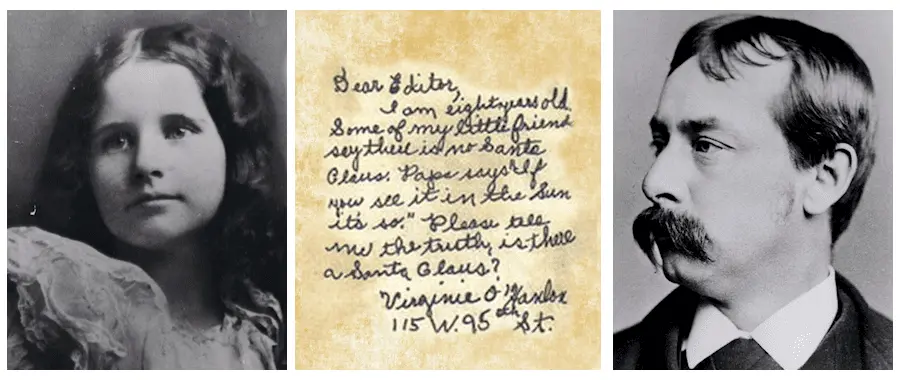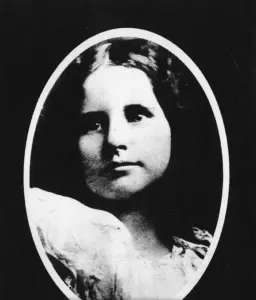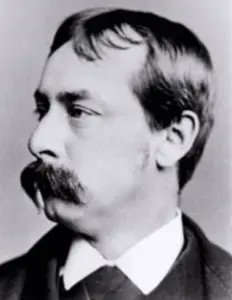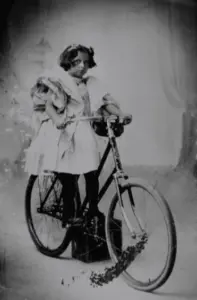In 1897, a young girl’s belief in Christmas magic was shaken. Virginia O’Hanlon’s friends teased her for believing in Santa Claus. She wrote to the New York Sun newspaper for the truth.
“Dear Editor, I am 8 years old. Some of my little friends say there is no Santa Claus. Papa says if you see it in the Sun, it’s so. Please tell me the truth. Is there a Santa Claus?”
Frank Church, a reporter who was going through a difficult time, answered her question. Church did not want to write the editorial and refused to allow his name to be attached to the piece. Church’s cherished response was, “Yes Virginia, there is a Santa Claus.”
But what of Virginia’s question of; is there a Santa Claus? Turns out Santa Claus is actually based on a real person. His name was Saint Nicholas, a fourth-century Greek bishop in Myra, Turkey. Saint Nicholas was a very religious man who loved to help people and give them gifts. He was famous for his generous gifts to the poor, in particular, presenting three impoverished daughters of a pious Christian with dowries so they would not have to become prostitutes. He devoted his life entirely to Christianity.
Over time the historical bishop of Myra was combined with a number of mythical figures including the British legend of Father Christmas, the Dutch figure of Sinterklaas, and the Germanic deity Wodan to create our modern Santa Claus. Santa Claus has many names reflecting his various cultural backgrounds; Father Christmas, Saint Nicholas, Saint Nick, Kris Kringle, or simply Santa.
In modern folklore, Santa Claus is said to make lists of the children throughout the world. He categorizes them according to their behavior. He then sets out to deliver presents, toys, and candy to all of the well-behaved children in the world. Misbehaving children receive coal on Christmas Eve.
Santa Claus is said to accomplish this feat with the aid of his elves, who make the toys in his workshop at the North Pole. Santa Claus’s flying reindeer pull his sleigh. He is commonly portrayed as living at the North Pole and laughing in a way that sounds like ho ho ho.
Santa Claus is generally depicted as a portly, jolly, white-bearded man, sometimes with spectacles, wearing a red coat with white fur collar and cuffs, white fur-cuffed red trousers, red hat with white fur, a black leather belt and black boots and carrying a bag full of gifts for children. This image became popular in the United States and Canada in the 19th-century due to the significant influence of the poem, “A Visit from St. Nicholas.”
In 1823, Clement Clarke Moore composed the poem on a snowy winter’s day during a shopping trip in a sleigh. His inspiration for the character of Saint Nicholas was a local Dutch handyman as well as the historic Saint Nicholas. Moore originated many of the features that are still associated with Santa Claus today while borrowing other aspects such as the use of reindeer. Moore portrayed his “jolly old elf” as arriving on Christmas Eve rather than Christmas Day.
The story in the poem is about a family settling down to sleep on Christmas Eve when the father is disturbed by noises on the lawn outside. Looking out his window he sees Saint Nicholas in an airborne sleigh pulled by eight tiny reindeer. Saint Nicholas lands his sleigh on the roof and enters the house down the chimney, carrying a sack of toys.
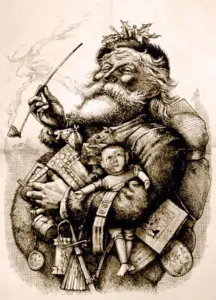
The world-renowned German-born American caricaturist and political cartoonist Thomas Nast played a large role in the creation of our image of Santa Claus. In 1881 his famous drawing, The Merry Old Santa Claus, became the modern image of Santa Claus. It was based on the traditional German figures of Sankt Nikolaus and Weihnachtsmann.
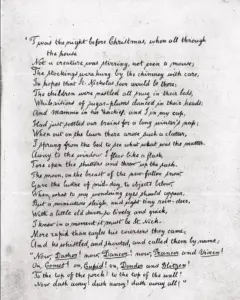
She started her career as an educator in 1912, became a junior principal in 1935, and retired in 1959. Virginia received a steady stream of mail about her letter throughout her life and would include a copy of the editorial in all her replies. In an interview later in life, she credited it with shaping the direction of her life quite positively.
In 1971 Laura Virginia O’Hanlon passed away at the age of 81. After seeing Virginia’s obituary in The New York Times, friends published a children’s book titled Yes, Virginia that illustrated the editorial and included a brief history of the main characters. Warner Brothers produced an Emmy award-winning television program based on the editorial in 1974.
The editorial has become a part of American popular Christmas folklore and the most reprinted newspaper editorial in the English language. It has been used many times in song, theatre, radio, television, children’s books, films, and advertising.
Today, the expression, “Yes, Virginia, there is (a)…” has become an idiomatic expression to insist that something is true.
Church’s original editorial read; “Yes Virginia, there is a Santa Claus. He exists as certainly as love, generosity, and devotion exist.”
I, for one, believe he’s right, there is a Santa Claus.
“He spoke not a word, but went straight to his work, And filled all the stockings; then turned with a jerk, And laying his finger aside of his nose, And giving a nod, Up the chimney he rose; He sprang to his sleigh, to his team gave a whistle, And away they all flew like the down of a thistle. But I heard him exclaim, ere he drove out of sight; Happy Christmas to all, and to all a good night.”
